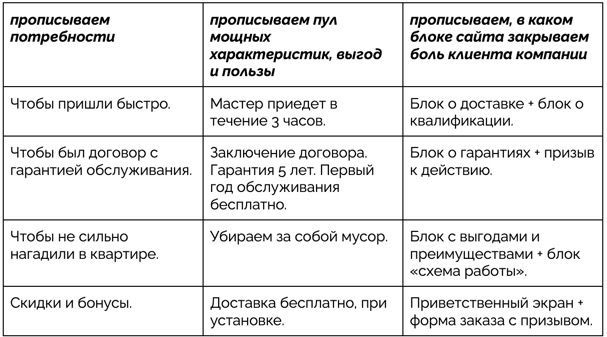The only correct answer is unique! We may disappoint you, but it's true – there is no perfect structure of the site. And if you are looking for a universal magic pill, this article is not for you.
A good working site is unique – the composition of its blocks and their sequence will be different in each specific case. The structure depends on many nuances: niche, market situation, product, competition, age of the company, duration of the transaction cycle, and so on. And yet, when creating a website, scrupulous preliminary work is very important. We share how we work on the project in our agency.
Let's highlight two main stages:
- preparatory work – takes 2-3 working days;
- development of the site structure and creation of texts – 3-5 days.
Usually two specialists work on the project: a marketer and a copywriter. But if necessary, we attract additional guys. At the preparatory stage, the marketer analyzes the target audience (CA) and competitors. Many people do not suspect that the development of the site begins with this, or neglect this issue, but in vain! Knowing what potential customers want and what competitors offer is the basis.
So, a study of the target audience. For a competent specialist, CA is not just an abstract "Sergey, 24 years old, from Moscow, above average income". Here it is important to dig deeper and identify specific current needs, so we always ask for help from the company itself. Which one? We tell them. If the company already has a customer base, we recommend collecting as much information as possible about the customer experience: contact them by phone, arrange a survey via messengers, organize a questionnaire directly at the time of purchase, etc. It is important for us to find out: why they buy from this company, what problems they face at the time of purchase or service, whether they are solved (and how successfully) these problems. By the way, if you already collect such information, you are most likely one step ahead of most competitors!
If there are no customers or the company has not provided us with such information, we try to get it ourselves: we study response sites, thematic forums, social networks, Yandex Wordstat. We scrupulously study reviews and discussions of living people – we need negative reviews, from them we get a list of needs and objections, on the basis of which we will build the structure of the site. We divide the resulting list into frequent (key) and rare (secondary). Next, we go to study the competitors. We start with direct ones – those with whom the company competes for customers directly. We compare firms by the level of satisfaction of the needs that we have identified in the analysis of the CA. As a result of these manipulations, we clearly see the strengths and weaknesses of the business – this will help us create the most profitable offer on the market.
For a deeper analysis, you can also take indirect competitors, for example, from another advertising source or city. So, we have compiled a list of needs and objections, and we have seen how our client's competitors handle them. Now our task is to rebuild the customer from these competitors. And we will do it through a competent website structure!
Clearly the work done looks like this:

Now we have everything on the shelves, and we see which blocks on the site we need.
By the way, you need to arrange the blocks similarly to the degree of importance of the needs that they cover – from the main to the secondary. Plus, we add expert explanatory blocks: "about the company", "contacts", "directions", "reviews", etc.
And only after this time-consuming work do we move on to writing texts. After all, now we know exactly where, about what and how we will talk. Texts should be contextual, literate, "without water", supported by facts and statistics – the reader always feels care and truth.
And now answer – is there a perfect landing page template?! The answer is obvious – even for one product, the structure and texts will be different. If you need a strong website and you plan to develop your business for many more years, contact an agency where there is a competent marketer and copywriter. After all, the result of the team of designers, coders and programmers depends on their work on the structure of the future site.

